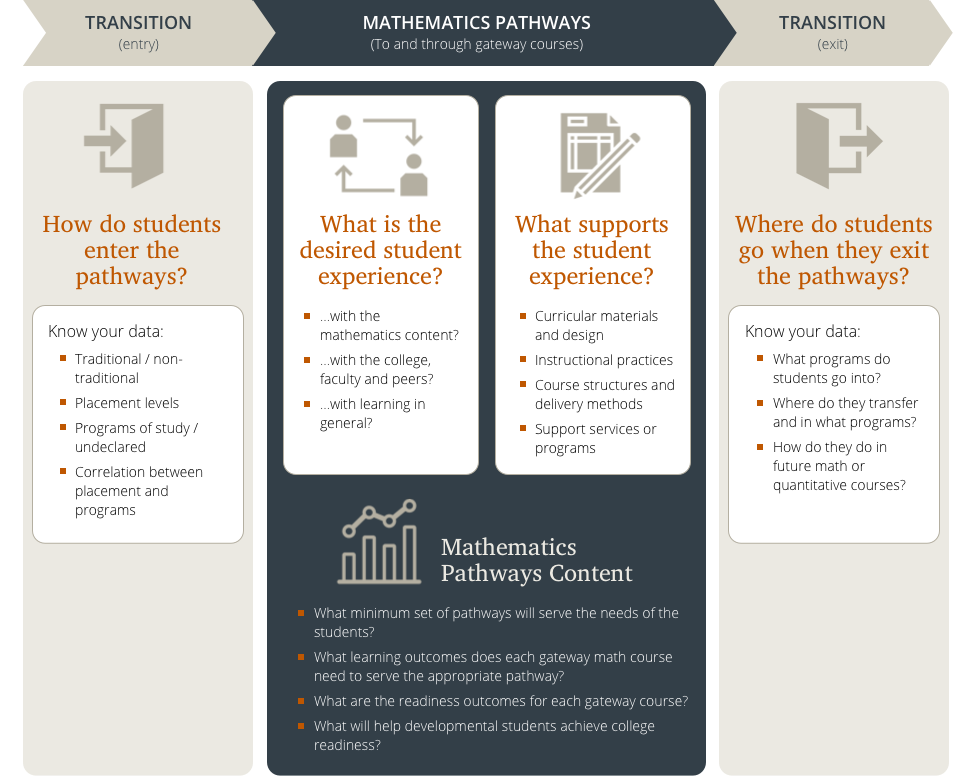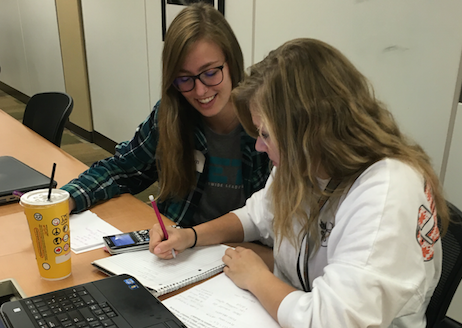The design of specific mathematics pathways is based on a “pathways perspective” in which each course is viewed as part of a pathway. There is careful attention on the student experience within the mathematics pathways as well as transition points (i.e., how students enter and where they go when exiting pathways).
This concept of a “pathways perspective” is true even if a student only takes one mathematics course. The Elements of Mathematics Pathways Design graphic illustrates the pathways perspective and provides guiding questions for each portion of the pathway.

Any institutional work first needs to be informed by state-level course learning outcomes or other requirements to ensure that courses are transferable. In states in which this is applicable, these state-level requirements set a broad outline for courses, which can be further defined by local faculty.
Thus far, faculty from major programs of study have assisted mathematics pathways implementation by: a) defining mathematics skills needed for different programs of study (Essential Action 4), which helped the institution define which mathematics pathways were needed at the institution (Essential Action 5), and b) establishing a default mathematics course in alignment with different programs of study (Essential Action 7).
In this essential action, the leadership team can establish teams comprised of gateway mathematics faculty and faculty from major programs of study to review materials appropriate to a program. For example, health sciences faculty could be included in reviewing statistical reasoning courses. These teams will gather sources to define the content of mathematics pathways courses. These sources may include state learning outcomes and requirements, examples of courses from other states and institutions, recommendations from mathematics associations, and information from client disciplines.
Resources to support defining the content of mathematics pathways courses can be found on the DCMP resource site, Pathways Curricular Materials.
To support students who are deemed underprepared for college-level mathematics courses, the leadership team needs to backward map learning outcomes from the readiness competencies of each college-level course. Gateway mathematics faculty members should complete this work. Course content should be selected based on the mathematical skills needed to be successful in the college-level course. Keep in mind that readiness competencies should not be considered prerequisite skills or a barrier to enrollment. Supplemental supports can enable students to complete these courses successfully.
Resources
facilitates the process of backmapping learning outcomes from the readiness competencies of the college-level course.
describes topics and concepts necessary for success in statistics.
Stephanie Doyen of Lone Star College – Kingwood talks about her experience teaching a course aligned with the Dana Center Mathematics Pathways Model.
The leadership team should plan for how students will receive academic support, such as tutoring. Because the mathematics courses will contain different content and use a different instructional model than traditional mathematics courses, the resources that are traditionally available to students may need realignment. Inform and train tutors so that their understanding of mathematics and instruction is specific to the new courses and consider technology and other resources that may support students.
Practitioner Point of View
Students who are struggling in mathematics can often find academic support in the form of one-on-one tutoring and drop-in help labs, which are commonplace at both two-year and four-year institutions. These supports provide personalized interventions and often play a key role in helping students succeed in gateway mathematics courses. Identifying effective practices in these types of student services, however, is a challenge that many institutions face.
Oklahoma State University (OSU) sought to address this challenge, which led to a revitalized mathematics support center that not only helps students through use of data-proven practices, but also serves as a center for ongoing research to improve its student support practices. OSU's approach - found in the Dana Center's " Notes from the Field -- Number 3view full resourceDownloadFile" - provides lessons to others engaged in similar efforts.

Sustaining mathematics pathways at scale requires a deep pool of faculty to teach the courses and to serve as leaders and mentors. Many innovations fail or discontinue because they are dependent on a few individuals who cannot sustain or grow the work over time. By providing ongoing professional learning and other resources for faculty and staff, high-level administrators and the leadership team signal their commitment to mathematics pathways.
To build faculty capacity for teaching new courses, consider these strategies:
- Identify faculty needs through surveys, focus groups, or interviews.
- Send faculty and staff to training sessions about mathematics pathways, or establish local training or discussion forums.
- Encourage connections with faculty and advisors at other institutions, particularly those nearby with whom your institution may share transfer partners.
- Provide opportunities for staff to work together to explore relevant topics through study groups.
Faculty will benefit from release time to engage in these activities. Consider reallocating institutional resources or seeking new funding to support this learning.
Practitioner Point of View
Lone Star College (LSC)–Kingwood created strategic networks with its transfer partners to build support for implementation of mathematics pathways. Kingwood President Katherine Persson contacted the University of Houston (UH) president, Renu Khator and the two presidents arranged for their respective mathematics faculty to connect. Stephanie Doyen, mathematics professor at LSC–Kingwood, invited her UH counterpart to observe her Foundations of Mathematical Reasoning class. This experience helped the UH faculty member understand the goals and purpose of the course in a more meaningful way than by simply reading the course outline and learning outcomes.
Bill Holda, former president of Kilgore College, assessed that many small rural community colleges in the state, such as Kilgore College, do not have a single primary transfer partner. To address this challenge, his strategy was to invite a consortium of two-year and four-year institutions to discuss mathematics pathways, transfer, and program alignment. Representatives from Stephen F. Austin State University, Texas A&M–Commerce, and The University of Texas at Tyler attended the meeting. Holda coordinated with Temple College to invite the University of North Texas to participate in the Transfer Champions Initiative, which sought to foster collaboration of two-year colleges and four-year universities in Texas to improve alignment of math pathways between transfer institutions. He plans to include more two-year institutions, such as Trinity Valley Community College, to coordinate engagement with four-year institutions in the region.
Reflection Questions
What does the mathematics department need in order to provide:
- Support for scheduling departmental meetings, disseminating information, collecting data, etc.?
- Training?
- Release time?
- Supplies and technology to implement classroom activities?
How and when will the mathematics department and leadership team share key lessons and findings across stakeholder groups?
How will separate developmental and college-level mathematics departments work together and coordinate work?
What is the deadline for classes to be listed in the fall catalog and placed on the fall schedule?
What qualifications must faculty have in order to teach the courses?
What do tutors need to know in order to tutor students in newly designed mathematics courses?
What training will be provided for tutors and support staff?
